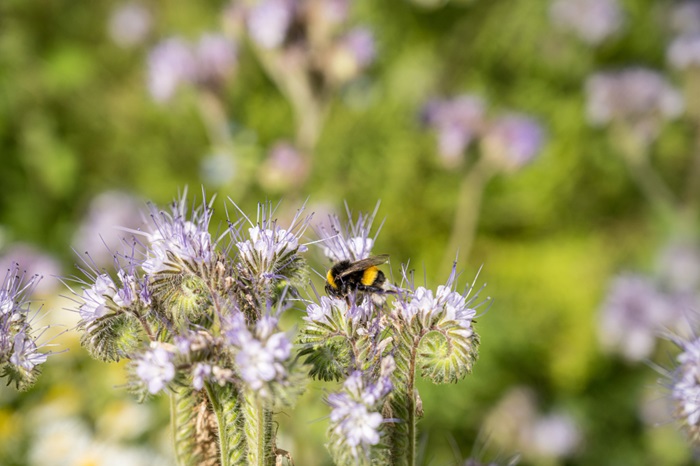Plants and Practices for a Bountiful Harvest
Attracting Pollinators to Your Vegetable Garden is one of the most effective ways to boost productivity, ensure healthier plants, and foster a vibrant, biodiverse environment. Pollinators such as bees, butterflies, and even certain bird species are essential partners for many vegetable crops, transferring pollen from flower to flower and facilitating fruit set. By creating a pollinator-friendly habitat, you not only improve the yield and quality of your vegetables but also support local ecosystems facing threats from habitat loss, climate change, and pesticide overuse. Below, you’ll discover best practices for selecting pollinator-attracting plants, designing a beneficial garden layout, and maintaining a healthy environment that encourages these vital creatures to visit—and stay.
Why Pollinators Are Essential to Vegetable Gardens
Pollinators are the unsung heroes of many thriving vegetable plots. They carry pollen between male and female flower parts, kickstarting the development of fruits like tomatoes, cucumbers, peppers, and squash. While some vegetables (like beans and peas) can self-pollinate, many rely on insects or birds for successful fertilization and abundant yields.
Key Benefits of Encouraging Pollinators
- Increased Crop Yield
A well-pollinated garden typically produces more fruits per plant and a higher overall harvest. - Better Fruit Quality
When flowers receive ample pollen, fruits tend to develop more uniformly and reach full size. - Biodiversity Boost
A pollinator-friendly garden supports an array of beneficial organisms, helping maintain ecological balance. - Reduced Need for Chemicals
A healthy pollinator population often correlates with fewer pests, as predatory insects and birds keep harmful bugs in check.
If you’re new to growing your own produce, our post on Vegetable Gardening for Beginners: Tips and Tricks for First-Time Gardeners can help you lay a solid foundation before diving into the specifics of attracting pollinators.
Understanding the Pollinators in Your Vegetable Patch
Different pollinators bring unique advantages to your garden. By learning which species are most helpful to your crops, you can tailor your plant selection and gardening practices accordingly.
Common Types of Pollinators
- Bees:
Honeybees, bumblebees, and solitary species (like mason bees) are the main workhorses for pollinating vegetable plants. They exhibit “flower constancy,” meaning they often stick to one flower species per foraging trip, ensuring effective pollen transfer. - Butterflies:
Although not as efficient at pollination as bees, butterflies contribute beauty and biodiversity. With their keen sense of smell and preference for bright blooms, they help pollinate a variety of garden crops and ornamentals. - Hummingbirds:
More common in certain regions, hummingbirds prefer tubular flowers rich in nectar. While they might not visit every vegetable plant, they can help transfer pollen on species that produce blooms with elongated shapes. - Other Insects:
Beetles, flies, wasps, and moths also pollinate. Although they aren’t as specialized as bees, their presence still contributes to your garden’s overall health.
Designing a Pollinator-Friendly Vegetable Garden Layout
A strategic layout is crucial for Attracting Pollinators to Your Vegetable Garden. By clustering flowering plants, providing shelter, and ensuring a consistent food source, you create an environment that pollinators find irresistible.
Grouping Crops and Companion Plants
- Flower Borders
Plant a border of pollinator-attracting flowers around your vegetable plots. Flowers such as marigolds, nasturtiums, and zinnias offer nectar and pollen while also deterring some pests. - Intercropping
Mix pollinator-friendly blooms among your vegetables. Herbs like basil, thyme, and cilantro produce small but numerous flowers that bees adore. - Succession Planting
Stagger your planting schedule so that different crops (and their blooms) appear throughout the growing season, guaranteeing a continuous supply of nectar.
For more ideas on pairing crops for mutual benefits, see our article on Companion Planting in the Vegetable Garden. You’ll learn how specific plant combinations can naturally repel pests while attracting beneficial insects.
Creating Pollinator Pathways
- Path Placement
Establish paths through your garden with stepping stones or mulch to reduce soil compaction. Pollinators can more easily navigate through clear walkways and transitional zones, leading them from one flower cluster to another. - Sunlight and Shade
Most pollinators prefer sunny areas with minimal wind. Incorporate windbreaks like shrubs or fences, ensuring you leave open patches of sunlit land for nectar-rich blooms.
Top Flowering Plants to Lure Pollinators
For Attracting Pollinators to Your Vegetable Garden, choose flower varieties that provide abundant nectar and pollen. Aim for a diversity of shapes, sizes, and colors to cater to different pollinator species.
Bee and Butterfly Favorites
- Lavender
- Aromatic herb that draws bees and butterflies with its fragrant purple blooms.
- Offers a long flowering period, providing a steady food source.
- Sunflowers
- Bright yellow heads attract a variety of bees and birds.
- Large central disc offers ample pollen, while seeds feed wildlife.
- Cosmos
- Daisy-like flowers that bloom continuously, ensuring a reliable nectar supply.
- Ideal for beginner gardeners, as they’re easy to grow and maintain.
- Echinacea (Coneflower)
- Vibrant petals and cone-shaped centers draw bees and butterflies.
- Drought-tolerant and hardy, thriving in full sun.
- Borage
- Blue, star-shaped flowers produce nectar that bees find irresistible.
- Leaves and flowers are also edible, adding value to your garden.
If you’re eager to learn more about selecting the perfect seeds, check out our in-depth guide, Heirloom vs. Hybrid: Choosing the Best Vegetable Varieties for Your Garden. You’ll discover how seed lineage can influence flavor, pest resistance, and adaptability—factors that also affect pollinator attraction.
Organic Practices That Boost Pollinator Populations
While synthetic pesticides and fertilizers may promise quick solutions, they can harm beneficial insects and disrupt the delicate balance of your garden. Instead, adopt organic strategies that safeguard pollinators and maintain long-term garden health.
Reducing Chemical Use
- Targeted Spraying
If you must use pesticides, opt for organic formulas like neem oil or insecticidal soaps. Apply them directly to affected areas rather than broadcasting them across the entire garden. - Timing
Spray at dusk or dawn when pollinators are less active, and avoid treating open blooms.
Beneficial Insects for Natural Pest Control
- Ladybugs
- Feed on aphids, scale insects, and mites.
- Attracted by flowers like dill, fennel, and cosmos.
- Lacewings
- Larvae devour aphids and other soft-bodied pests.
- Prefer pollen and nectar from asters, sunflowers, and marigolds.
- Praying Mantises
- Eat a variety of insects, including caterpillars and beetles.
- Require dense foliage for camouflage and egg-laying.
To dive deeper into chemical-free pest management, read our post on Eco-Friendly Pest Control. It outlines practical strategies to handle common garden pests without endangering pollinators.
Water, Shelter, and Other Essentials for Pollinator Survival
Pollinators need more than just flowers. By providing clean water, nesting sites, and overwintering opportunities, you’ll transform your vegetable garden into a haven for beneficial critters.
Supplying Fresh Water
- Shallow Birdbaths
Fill with pebbles or stones so insects can land safely while drinking. Clean regularly to prevent algae growth and mosquito breeding. - Drip Trays
Place trays of water near flowering plants, adding small rocks for stable perches.
Creating Shelter and Nesting Sites
- Bee Hotels
- Simple wooden structures drilled with holes to accommodate solitary bees.
- Mount in a sheltered spot that gets morning sun and afternoon shade.
- Tolerate Untidy Corners
- Leave a small pile of leaves, stems, or logs for overwintering insects.
- Exposed soil patches can attract ground-nesting bees.
- Hedgerows
- Dense shrubbery provides wind protection, nesting areas, and additional nectar sources.
- Ideal for bordering your vegetable garden or separating different garden beds.
Best Practices for a Continuous Blooms Calendar
A major component of Attracting Pollinators to Your Vegetable Garden is ensuring they have access to nectar and pollen across the entire growing season. Stagger your flower choices by bloom time so there’s always a fresh food source available.
Seasonal Bloom Strategy
- Early Spring
- Plant crocuses, daffodils, or flowering fruit trees that bloom as pollinators emerge from winter dormancy.
- Mid-Summer
- Include lavender, salvias, and sunflowers that can handle intense heat while offering abundant nectar.
- Late Fall
- Grow asters, chrysanthemums, and late-blooming herbs (like oregano) for a final floral feast before the cold sets in.
A diverse planting schedule reduces the chances of a “nectar dearth,” a period when few blooms are available, forcing pollinators to look elsewhere.
Incorporating Native Plants for Local Pollinators
Native plant species have co-evolved with local pollinators, making them especially beneficial for both wildlife and your vegetable garden. Native wildflowers and grasses are often hardy, drought-tolerant, and naturally resistant to local pests.
Finding Native Varieties
- Local Nurseries
Many garden centers carry native plants well-suited to your climate and soil conditions. Look for tags indicating “native” or “locally grown.” - Regional Conservation Groups
Organizations like the Xerces Society offer guides to pollinator-friendly native plants by region. - Seed Exchanges
Check out local seed swaps or gardening clubs to discover heirloom or native seeds passed down through generations.
Handling Bees Safely and Responsibly
Encouraging bees can raise questions about stings, especially if you have children or visitors with allergies. However, most solitary bees and bumblebees are docile, stinging only when threatened.
Tips for Coexisting with Pollinators
- Respect Nesting Areas
Mark the vicinity of bee hotels or ground-nesting sites so family members know to approach carefully. - Wear Light Colors
Bees are less attracted to white or pastel clothing than dark or brightly colored garments. - Avoid Strong Perfumes
Sweet fragrances can confuse bees, causing them to hover or land on you.
Integrating Biodiversity Beyond Pollinators
A robust pollinator population is just one aspect of a thriving garden ecosystem. By encouraging beneficial birds, frogs, and other wildlife, you enhance pest control, nutrient cycling, and overall biodiversity.
- Bird Houses and Feeders
Birds not only pollinate certain plants but also feast on insects like caterpillars and beetles. - Water Features
Small ponds or water basins can support amphibians that help control slugs and mosquitoes. - Leaf Litter and Log Piles
Ground-dwelling creatures break down organic matter, returning nutrients to the soil.
Long-Term Maintenance for a Pollinator Paradise
Once you’ve laid the groundwork, ongoing care ensures that pollinators keep coming back. Consistency in watering, pruning, and soil enrichment makes your garden more resilient—and more inviting to beneficial insects.
Routine Tasks
- Deadheading Flowers
- Snip off spent blooms to encourage new flower growth, extending nectar availability.
- Regular Weeding
- Remove invasive species that might outcompete your pollinator-friendly plants.
- Soil Amendments
- Top-dress with compost or organic matter each season to feed both vegetables and flowering plants.
By balancing your garden’s needs with pollinator-friendly practices, you maintain a space that thrives year after year. To expand your knowledge of advanced growing techniques, consult Jeremy Payton’s indispensable guide, The Year-Round Vegetable Garden for Beginners. It delves into topics like long-term soil health, extended growing seasons, and eco-friendly problem-solving—key factors for a consistently flourishing vegetable garden.
Key Takeaways for a Pollinator-Friendly Vegetable Garden
Attracting Pollinators to Your Vegetable Garden is a multifaceted process that elevates both the beauty and productivity of your growing space. By thoughtfully selecting flowers, employing organic methods, and providing food, water, and shelter, you create an environment where bees, butterflies, and other beneficial creatures can thrive. A garden teeming with pollinators ultimately gives you a bountiful harvest, stronger plant health, and a sense of harmony with the natural world.
In summary, success rests on several pillars:
- Diverse, Sequential Blooms: Ensure continuous flowering throughout the season.
- Organic Pest Management: Protect pollinators by minimizing or eliminating chemical sprays.
- Native Plant Integration: Help local pollinators by incorporating region-specific species.
- Thoughtful Garden Design: Cluster plants, create pathways, and provide nesting sites for a balanced habitat.
If you’re seeking additional insights into sustainable gardening, be sure to check our Eco-Friendly Pest Control and Companion Planting in the Vegetable Garden posts. Together, these resources can guide you in crafting a holistic, pollinator-friendly approach that enhances your garden’s productivity and ecological value.


Leave a Reply